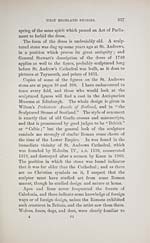Download files
Complete book:
Individual page:
Thumbnail gallery: Grid view | List view

336 CELTIC DKESS.
Tartans, therefore, especially some sets, ought to be
old. If not as old as the seventh century, they are at
least as old as 1G03, according to the author of
" Certayn Mattere Concerning Scotland," who says,
" they delight in marbled cloths, especially that have
stripes of sundrie colours ; they love chiefly purple and
blue ; their predecessors used short mantles or plaids
of diverse colours, sundrie ways divided, and among
some the same custom is observed to this day, but for
the most part they are brown, most near to the colour
of the hadder, to the effect, when they lie among the
hadders, the bright colour of their plaids shall not
bewray them ; with which, rather coloured than clad,
they suffer the most cruel tempests that blow in the
open fields, in such sort, that in a night of snow they
sleep sound."
Tartan was worn during the thirty years' war, and
the Germans thus described the wearers : —
In such dresses go the 800 Irrlander, or Irren, newly
arrived at Stettin, a.d. 1631.
" This is a strong hardy people, content with common
fare ; if they have no bread they eat roots, when need
requires it. They can run more than twenty German
miles in a day ; they have by them muskets, their bows
and quivers, and long knives."
There are plenty of bits of old tartan preserved in
Scotland. There are pictures at Dunrobin, at Tay-
mouth, at Armidale, at Holyrood and elsewhere, all of
which prove that tartan was anciently worn, and that
particular patterns were worn in certain districts.
Dr. Johnson and Boswell saw men dressed in plaids
and tartans when they made their tour in 1773, and
whence the notion sprang that the Highland dress is a
modern invention I cannot imagine, unless it is the off-
Tartans, therefore, especially some sets, ought to be
old. If not as old as the seventh century, they are at
least as old as 1G03, according to the author of
" Certayn Mattere Concerning Scotland," who says,
" they delight in marbled cloths, especially that have
stripes of sundrie colours ; they love chiefly purple and
blue ; their predecessors used short mantles or plaids
of diverse colours, sundrie ways divided, and among
some the same custom is observed to this day, but for
the most part they are brown, most near to the colour
of the hadder, to the effect, when they lie among the
hadders, the bright colour of their plaids shall not
bewray them ; with which, rather coloured than clad,
they suffer the most cruel tempests that blow in the
open fields, in such sort, that in a night of snow they
sleep sound."
Tartan was worn during the thirty years' war, and
the Germans thus described the wearers : —
In such dresses go the 800 Irrlander, or Irren, newly
arrived at Stettin, a.d. 1631.
" This is a strong hardy people, content with common
fare ; if they have no bread they eat roots, when need
requires it. They can run more than twenty German
miles in a day ; they have by them muskets, their bows
and quivers, and long knives."
There are plenty of bits of old tartan preserved in
Scotland. There are pictures at Dunrobin, at Tay-
mouth, at Armidale, at Holyrood and elsewhere, all of
which prove that tartan was anciently worn, and that
particular patterns were worn in certain districts.
Dr. Johnson and Boswell saw men dressed in plaids
and tartans when they made their tour in 1773, and
whence the notion sprang that the Highland dress is a
modern invention I cannot imagine, unless it is the off-
Set display mode to: Large image | Transcription
Images and transcriptions on this page, including medium image downloads, may be used under the Creative Commons Attribution 4.0 International Licence unless otherwise stated. ![]()
| Early Gaelic Book Collections > Matheson Collection > Popular tales of the west Highlands > Volume 4 > (354) |
|---|
| Permanent URL | https://digital.nls.uk/81491305 |
|---|
| Description | Volume IV. |
|---|---|
| Shelfmark | Mat.77 |
| Additional NLS resources: | |
| Attribution and copyright: |
|
| Description | Items from a collection of 170 volumes relating to Gaelic matters. Mainly philological works in the Celtic and some non-Celtic languages. Some books extensively annotated by Angus Matheson, the first Professor of Celtic at Glasgow University. |
|---|
| Description | Selected items from five 'Special and Named Printed Collections'. Includes books in Gaelic and other Celtic languages, works about the Gaels, their languages, literature, culture and history. |
|---|

